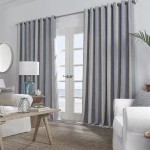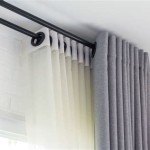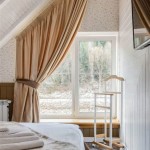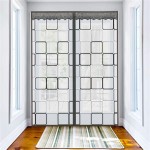Thermal Curtains That Let Light In: Balancing Energy Efficiency and Natural Light
Thermal curtains are often associated with blocking out sunlight completely, creating a dark and insulated room. While many thermal curtains excel at light blockage for improved sleep or enhanced media viewing, there is a growing demand for options that offer thermal benefits without sacrificing natural light. These curtains aim to strike a balance between energy efficiency and the desire for a bright, welcoming living space. This article explores the features, construction, and considerations when selecting thermal curtains designed to let light into a room.
The primary function of thermal curtains remains consistent: to regulate room temperature by minimizing heat transfer. In the winter, they prevent heat from escaping through windows, keeping the room warmer and reducing heating costs. Conversely, in the summer, they block solar heat gain, keeping the room cooler and reducing the need for air conditioning. This insulating effect is crucial for energy conservation and creates a more comfortable living environment year-round.
Traditional thermal curtains achieve their insulating properties through multiple layers of tightly woven fabric, often incorporating a thermal lining or a foam backing. These layers create a barrier against heat transfer, but they also effectively block out most, if not all, incoming light. The challenge lies in achieving a similar level of thermal performance while allowing a sufficient amount of daylight to enter the room.
Key Point 1: Materials and Construction for Light-Filtering Thermal Curtains
The core difference between traditional blackout thermal curtains and those designed to let light in lies in the materials and construction techniques used. The goal is to create a fabric that has a degree of opacity that minimizes heat transfer but still allows light to pass through.
One common approach is to utilize a lighter-colored thermal lining. Darker colors absorb more heat, while lighter colors reflect it. By using a lighter shade for the lining, a portion of the sunlight is reflected back into the room, instead of being absorbed and contributing to heat buildup. However, the lining still provides a significant thermal barrier, reducing the overall heat transfer.
Another strategy involves employing a tightly woven fabric with a specific weave pattern. Certain weave patterns, such as a twill weave, can provide a denser structure that offers better thermal insulation than a looser weave, while still allowing some light to filter through. The density of the weave affects both the amount of light that passes through and the insulation level.
Innovations in fabric technology have also led to the development of specialized thermal fabrics. Some manufacturers use a thin, metallic coating on the back of the fabric to reflect heat without significantly affecting the light transmission. This coating acts as a radiant barrier, reflecting infrared radiation back into the room in the winter and away from the room in the summer.
The number of layers in the curtain construction is also a crucial factor. While multiple layers generally provide better insulation, they also tend to block more light. Light-filtering thermal curtains often use fewer layers or thinner layers compared to their blackout counterparts. This trade-off between insulation and light transmission must be carefully considered when selecting the appropriate curtain for a specific need.
The face fabric, the outer layer of the curtain, also plays a role in light filtration. Lighter-colored fabrics, such as white, beige, or pastel shades, will naturally allow more light to pass through than darker colors like navy blue or black. The texture of the fabric can also influence light diffusion. A smooth fabric will allow light to pass more directly, while a textured fabric will scatter the light, creating a softer, more diffused glow.
Key Point 2: Understanding Light Control and Thermal Performance
It is important to understand that thermal curtains designed to let light in will not provide the same level of light blockage as blackout curtains. They aim to soften the light and reduce glare, creating a more comfortable and usable space during the day, rather than completely darkening the room.
The amount of light that passes through the curtain will depend on several factors, including the color and density of the fabric, the weave pattern, and the amount of sunlight available. A light-colored curtain in a room with strong sunlight will allow significantly more light to enter than a darker curtain in a room with limited sunlight.
Similarly, the thermal performance of these curtains will not match that of blackout thermal curtains. While they still provide a noticeable improvement in energy efficiency, they will not be as effective at preventing heat transfer. The trade-off is that they allow a greater degree of natural light to enter the room, which can contribute to a more pleasant and productive environment.
When choosing thermal curtains that let light in, it's useful to look for standardized ratings, although these may not always be readily available. Researching the materials and construction of the curtain, along with reading customer reviews, can provide valuable insights into its actual performance.
Consider the orientation of the windows. Windows facing south or west receive more direct sunlight and heat, requiring a more robust thermal solution than windows facing north or east. Light-filtering thermal curtains may be more suitable for north- or east-facing windows, where the need for intense heat blockage is less critical.
The desired level of privacy should also be considered. While these curtains allow light to pass through, they still provide a degree of privacy by obscuring the view from outside. However, they may not offer complete privacy, particularly at night when the lights are on inside the room. If privacy is a primary concern, consider layering the curtains with blinds or shades.
Key Point 3: Practical Considerations for Selecting and Using Light-Filtering Thermal Curtains
Beyond the materials and performance characteristics, several practical considerations should be kept in mind when selecting and using light-filtering thermal curtains.
The style and aesthetics of the curtains should complement the existing décor of the room. These curtains are available in a wide range of colors, patterns, and textures, allowing them to seamlessly integrate into various design styles.
The ease of maintenance is also an important factor. Consider the cleaning requirements of the fabric. Some fabrics may require professional cleaning, while others can be easily machine washed. Choose a fabric that is durable, stain-resistant, and easy to care for.
The hanging method of the curtains can also influence their thermal performance. Curtains hung close to the wall, with minimal gaps, will provide better insulation than curtains that are hung loosely. Consider using a wraparound curtain rod to minimize drafts around the edges of the curtains.
The length of the curtains is another important consideration. Curtains that extend to the floor or even slightly puddle on the floor will provide better insulation than curtains that are shorter. The extra fabric at the bottom helps to prevent drafts from entering the room. However, ensure that the curtains do not obstruct doorways or create a tripping hazard.
The cost of light-filtering thermal curtains can vary widely depending on the materials, construction, and brand. It is important to set a budget and compare prices from different retailers before making a purchase. While investing in high-quality curtains may involve a higher initial cost, the long-term energy savings and increased comfort can justify the investment.
Finally, consider layering light-filtering thermal curtains with other window treatments, such as blinds or shades. This allows for greater control over both light and temperature. During the day, the blinds or shades can be opened to allow natural light to enter, while the thermal curtains provide insulation. At night, the blinds or shades can be closed for added privacy and light blockage, while the thermal curtains continue to provide insulation.
By carefully considering the materials, construction, performance characteristics, and practical considerations outlined above, individuals can select and use thermal curtains that effectively balance energy efficiency with the desire for a bright and welcoming living space. The goal is not necessarily to completely block out light, but rather to manage it effectively, creating a more comfortable and energy-efficient environment.

Light Natural Cotton Eyelet Blackout Thermal Curtains From Next Finland

The Best Blackout Curtains To Block Light In 2024

The Best Blackout Curtains To Block Light In 2024

Light Blue Cotton Eyelet Blackout Thermal Curtains From Next Finland

Deconovo Thermal Insulated Blackout Curtains 52x72 Inch Grommet Room Darkening Window For Bedroom Light Beige Set Of 2 Panels Wal Com

Insulated Curtains Light Eyelets Silent Sliding Thermal Protection Green 84w X 102l Cm 2pcs Home Decor Noise Reduction Energy Conserving Pan Fruugo Fi

Light Natural Cotton Blackout Thermal Eyelet Curtains From The Next Uk

8 Best Blackout Curtains Of 2024 Shades For Light Sleepers

Primebeau 100 Blackout Curtains Full Light Blocking Curtain Draperies For Bedroom Living Room Thermal Insulated Functional Soft Thick Window Treatment 52x108 Inches Grey Wal Com

The Best Blackout Curtains Reviews By Wirecutter








